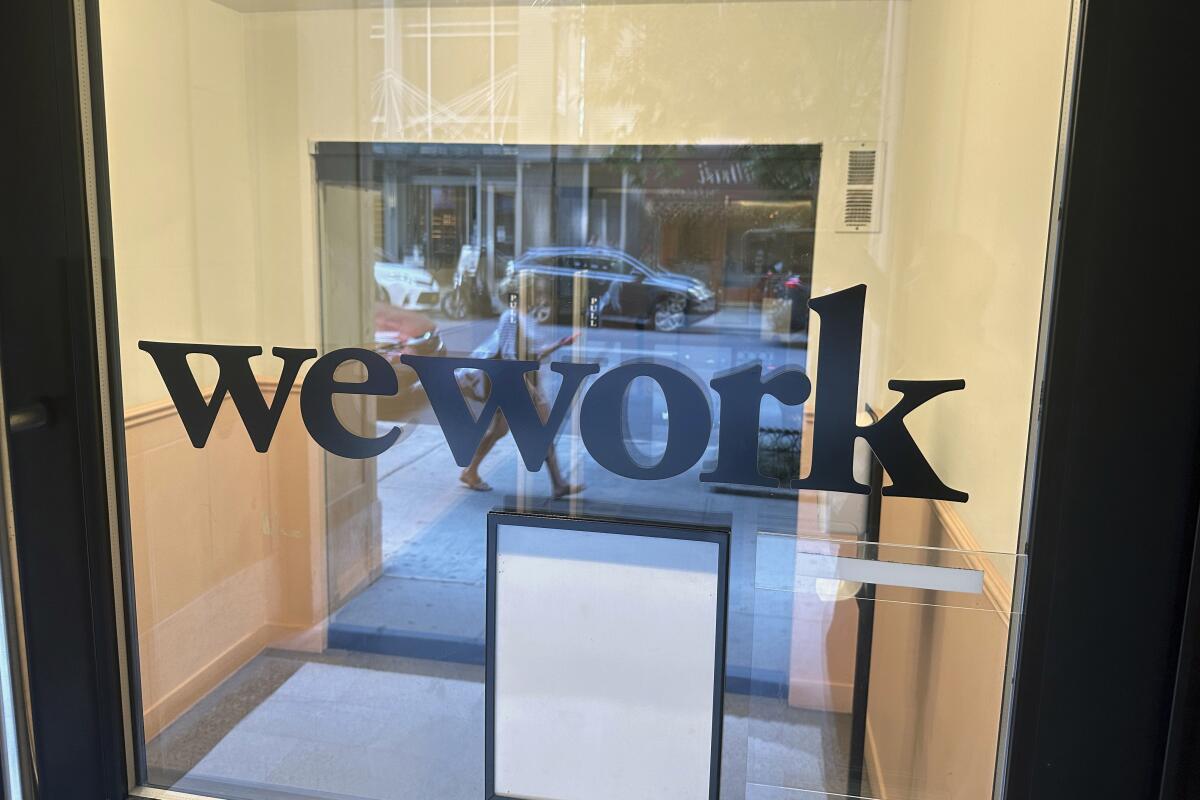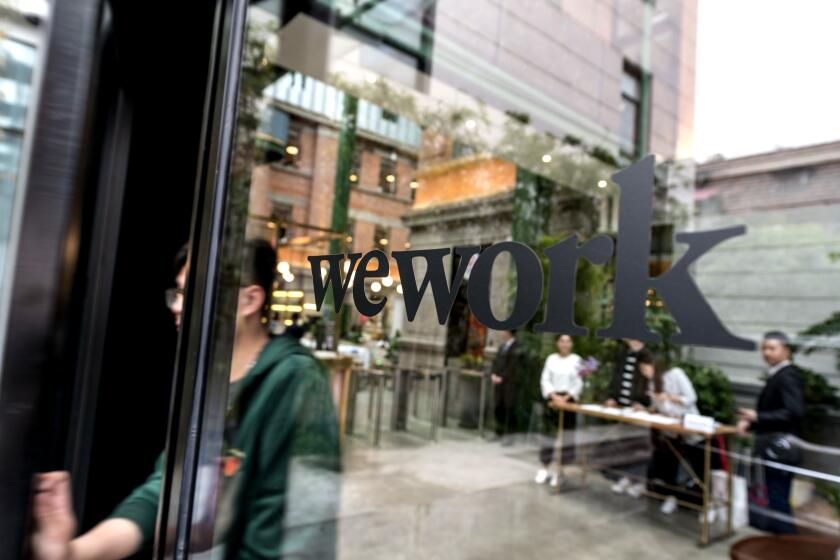Once valued at $47 billion, WeWork files for bankruptcy protection in spectacular fall

- Share via
NEW YORK — WeWork has filed for Chapter 11 bankruptcy protection, marking a stunning fall for the office-sharing company once seen as a Wall Street darling that promised to upend the way people went to work around the world.
In a late Monday announcement, WeWork said it had entered into a restructuring support agreement with the majority of its stakeholders to “drastically reduce” the company’s debt while further evaluating its commercial office-lease portfolio.
WeWork is also requesting the “ability to reject the leases of certain locations,” which the company says are largely non-operational, as part of the filing. Estimates of the total number of affected locations were not disclosed Monday, but all affected members have received advance notice, the company said.
“Now is the time for us to pull the future forward by aggressively addressing our legacy leases and dramatically improving our balance sheet,” WeWork Chief Executive David Tolley said in a prepared statement. “We defined a new category of working, and these steps will enable us to remain the global leader in flexible work.”
The specter of bankruptcy has hovered over WeWork for some time. In August, the New York company sounded the alarm over its ability to remain in business. Cracks had begun to emerge several years ago, not long after the company was valued as high as $47 billion.
WeWork is paying the price for aggressive expansion in its early years. The company went public in October 2021 after its first attempt to do so two years earlier collapsed spectacularly. The debacle led to the ouster of founder and Chief Executive Adam Neumann, whose erratic behavior and exorbitant spending spooked early investors.
Adam Neumann, WeWork’s co-founder and former CEO, was due to receive $185 million pending a stock sale as part of his exit package. But SoftBank, WeWork’s main backer, has called off the transaction.
Japan’s SoftBank stepped in to keep WeWork afloat, acquiring majority control over the company.
In a prepared statement Monday ahead of WeWork’s official announcement, Neumann called the bankruptcy filing disappointing and said it had been challenging for him “to watch from the sidelines since 2019 as WeWork has failed to take advantage of a product that is more relevant today than ever before.”
Still, he added, a strong reorganization could allow WeWork to emerge successfully.
Despite efforts to turn the company around since Neumann’s departure — including significant cuts to operating costs and rising revenue — WeWork has struggled in a commercial real estate market that has been rocked by rising costs of borrowing money, as well as a shifting dynamic for millions of office workers now checking into their offices remotely.
Three days after withdrawing its IPO filing, the formerly high-flying start-up WeWork informs staff of deep job cuts by the end of October.
In Monday’s filing, WeWork listed about $18.7 million in debts and $15.1 million in assets as of June 30.
In September, when WeWork announced plans to renegotiate nearly all of its leases, Tolley noted that the company’s lease liabilities accounted for more than two-thirds of its operating expenses for the second quarter of this year — remaining “too high” and “dramatically out of step with current market conditions.”
At the time, WeWork also said it could exit more underperforming locations. As of June 30, the latest date with property numbers disclosed in securities filings, WeWork had 777 locations in 39 countries.
Beyond real estate costs, WeWork has pointed to increased member churn and other financial losses. In August, the company said that its ability to stay in operation was contingent upon improving its liquidity and profitability overall in the next year.
The back-to-the-office campaign by many employers has run into resistance from workers. They’ve struck a truce of sorts — hybrid work.
WeWork’s bankruptcy filing arrives at a time when leasing demand for office space is weak overall. The COVID-19 pandemic notably led to rising vacancies in office space as working from home became increasingly popular — and major U.S. markets, from New York to San Francisco, are still struggling to recover.
In the U.S., experts note that WeWork’s 18 million square feet is a small fraction of total office inventory in the country but that, on a building-by-building level, landlords with exposure to WeWork could take significant hits if their leases are terminated.
The shuttering of select WeWork locations to cut costs isn’t new. In some past cases, landlords’ building loans moved to special servicing after losing WeWork as a tenant, credit rating and research firm Morningstar Credit previously told the Associated Press.
While the full impact of this week’s bankruptcy filing on WeWork’s real estate footprint is still uncertain, the company sounded an optimistic note Monday night.
Start your day right
Sign up for Essential California for the L.A. Times biggest news, features and recommendations in your inbox six days a week.
You may occasionally receive promotional content from the Los Angeles Times.
“Our spaces are open and there will be no change to the way we operate,” a WeWork spokesperson said in a statement to the Associated Press. “We plan to stay in the vast majority of markets as we move into the future and remain committed to delivering an exceptional experience and innovative flexible workspace solutions for our members.”
WeWork and certain entities filed for Chapter 11 bankruptcy protection in U.S. District Court in New Jersey, with plans to also file recognition proceedings in Canada, according to Monday’s announcement.
WeWork locations outside of the U.S. and Canada will not be affected by the proceedings, the company said, as well as franchisees worldwide.
More to Read
Inside the business of entertainment
The Wide Shot brings you news, analysis and insights on everything from streaming wars to production — and what it all means for the future.
You may occasionally receive promotional content from the Los Angeles Times.













